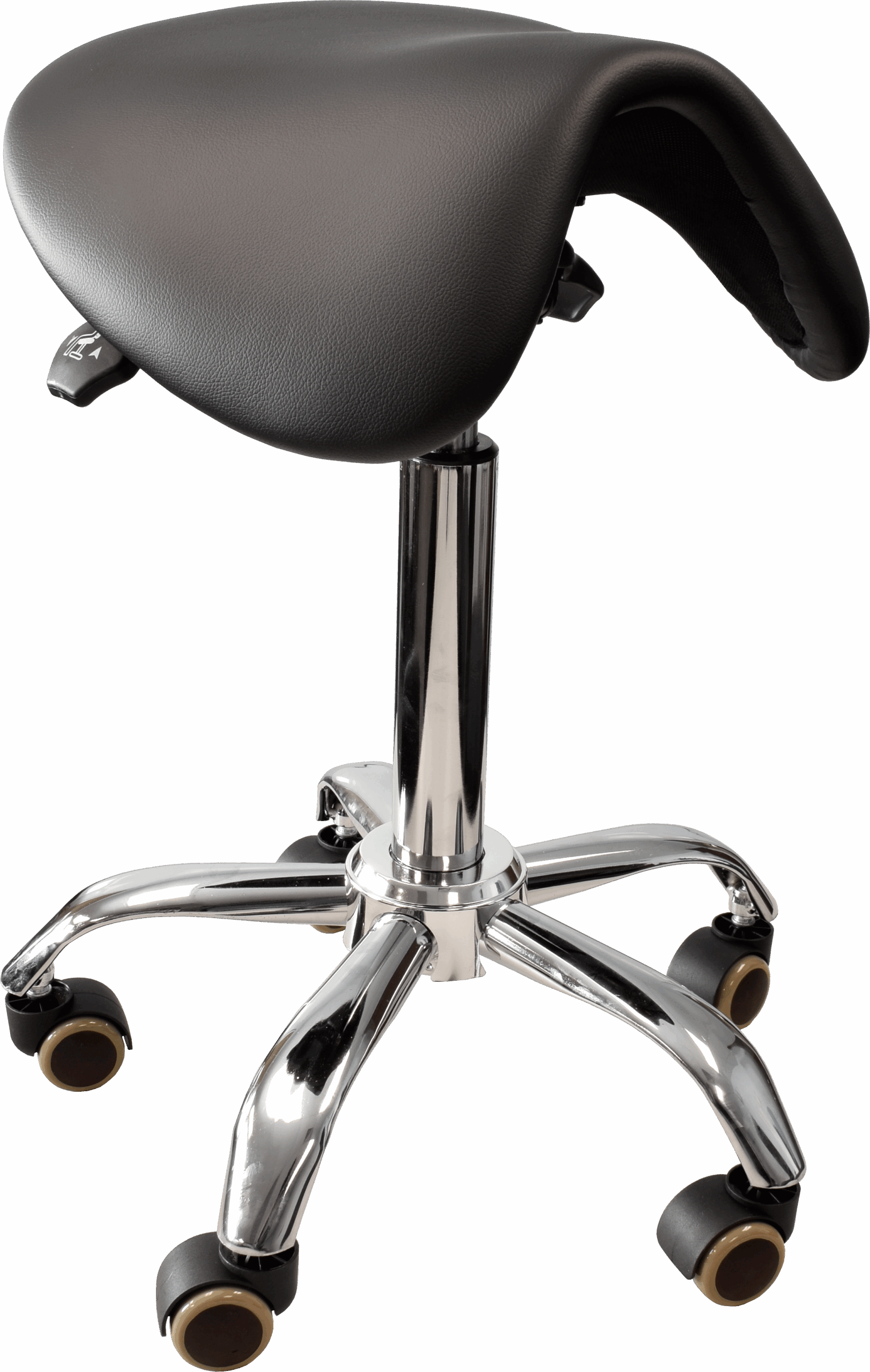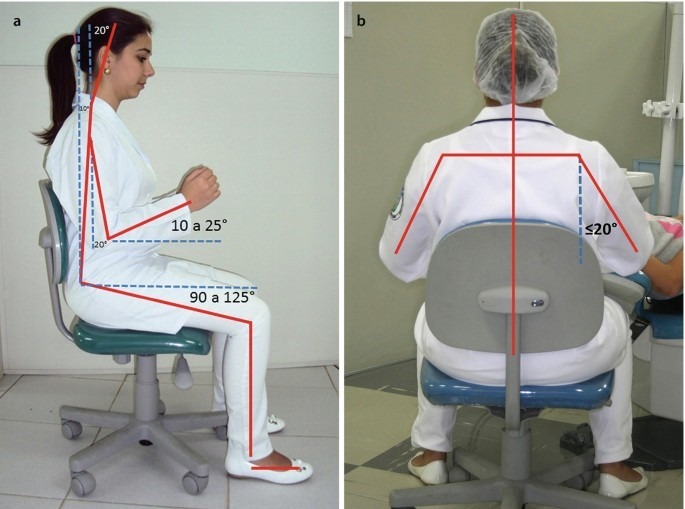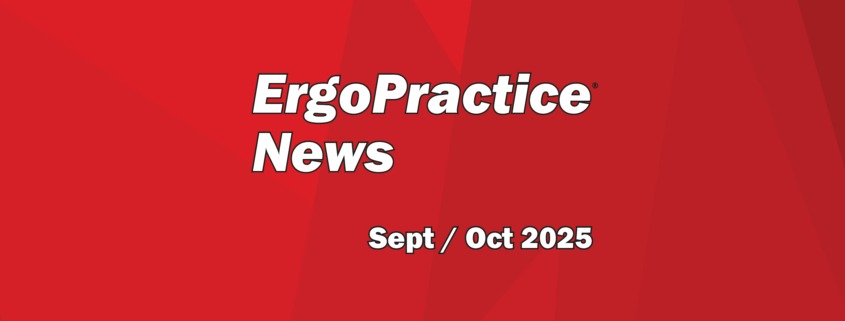Beyond Neck Tilt: A Holistic Approach to Clinician Ergonomics

ErgoPractice News Whitepaper – Sept/Oct 2025
By Paul Wisniewski, CSSGB
paulw@surgitel.com
Summary
Competitor marketing often focuses narrowly on posture, promoting loupe systems that claim to eliminate musculoskeletal risk through single features such as fixed deflection angles or refractive optics. While posture is undeniably an important factor, research demonstrates it represents only one dimension of the complex ergonomic challenges faced by dental and surgical clinicians.14,16
SurgiTel’s approach recognizes that clinician health is impacted by multiple variables: posture, vision, seating, lighting, weight distribution, workflow efficiency, and training. This white paper expands on our holistic framework by highlighting additional ergonomic tools and solutions, including Front-Lens-Mounted (FLM) loupes, Hybrid Ergo™, ErgoDeflection™, the ErgoSit™ saddle stool, and athletic posture training, all designed to advance long-term health, performance, and career sustainability.
The Limits of “Neck Tilt” Solutions
The prevalence of musculoskeletal disorders (MSDs) among clinicians is well documented, with 60-80% of dental professionals reporting chronic pain in the neck, shoulders, and back.1,2 Competitors have responded with loupe designs emphasizing neutral neck posture through fixed declination or refractive optics. While improving neck angle reduces one area of strain, it does not address other critical factors. Many clinicians continue to report fatigue and discomfort even when using posture-focused systems.3
True ergonomics must be comprehensive. Neck tilt alone is only part of the story.
The Broader Ergonomic Challenge in Dentistry & Surgery
- Prolonged Static Positioning: Holding fixed postures for hours accelerates fatigue and musculoskeletal loading.4
- Visual Strain: Inadequate optics and poor lighting force micro-adjustments, compounding fatigue.5
- Weight and Balance: Heavy or poorly balanced headborne equipment increases cervical torque and shoulder strain.6
- Operatory Layout: Poor seating and equipment placement encourage compensatory movements.7
- Training Gaps: Clinicians often lack instruction in ergonomic seating and athletic posture.
Impact: MSDs are among the leading causes of discomfort, reduced career longevity, and early retirement for dental and surgical professionals. While specific cost estimates for healthcare are limited, OSHA estimates that MSDs cost U.S. employers around $20 billion annually in direct costs across all industries, with total economic impact likely much higher.8
SurgiTel’s Holistic Ergonomics Framework
Posture & Customization
- Front-Lens-Mounted (FLM) Loupes: Lightweight, customizable, and ideal for clinicians seeking precise declination without extra bulk. Perfect for intermittent or mobile use.
- Hybrid Ergo™ Loupes: SurgiTel’s flagship ergonomic solution combines the clarity of traditional loupes with ergonomic declination, a balanced solution for general clinicians.
- ErgoDeflection™ Loupes: Offering maximum neck and back relief during long procedures with custom deflection prism technology.
- Why It Matters: Competitors force clinicians into rigid optical angles. SurgiTel provides a spectrum of ergonomic solutions, ensuring the right fit for every clinician.
Any Way You Ergo, SurgiTel Builds It That Way
Stop settling for one-size-fits-all loupes. Your neck deserves a break! At SurgiTel, we know every clinician has their own style, some lean in, some sit tall, some move between positions throughout the day. That’s why every SurgiTel loupe is built around your unique working angle and fit. Want a steeper angle? No problem. Need them a little shallower? Got you covered.
With SurgiTel, you get a system crafted to match your workflow, so you can work comfortably, see clearly, and protect your career. Because when it comes to ergonomics, there’s no such thing as one-size-fits-all.
Proper Working Distance
A proper working distance is essential for ergonomic hand, arm, and upper body placement. When the distance is too short, clinicians are forced to raise their arms and hands uncomfortably high, creating sustained shoulder and trapezius tension. Over time, this can lead to chronic shoulder pain and rotator cuff injuries. A short working distance also encourages clinicians to lean forward in order to remain in focus, compounding neck and back strain. Conversely, a distance that is too long can cause clinicians to stretch or hunch awkwardly, which similarly disrupts ergonomic balance.
The correct working distance provides a foundation for healthy posture of the hands, arms, and shoulders, allowing clinicians to work with relaxed upper limbs and a neutral spine. It also directly impacts visual clarity and procedural precision. SurgiTel offers full customization of working distance based on each clinician’s body size, seating preferences, and typical operatory setup. Unlike one-size-fits-all solutions, SurgiTel’s approach ensures that the optics are tailored to the user’s ergonomic zone rather than forcing the user to adapt their posture to the equipment.
For additional fine-tuning, SurgiTel’s patented working distance caps provide precise incremental adjustment. These caps allow clinicians to adjust the focus point quickly and easily without compromising posture, which is particularly valuable for multi-user settings, clinicians with varying procedure types, or environments where both sitting and standing are required. This adaptability supports long-term musculoskeletal health and reduces fatigue while maintaining high clinical accuracy.
Seating Ergonomics

ErgoSit Saddle Stool
- The ErgoSit™ Saddle Stool: Clinicians spend thousands of hours seated each year. Traditional stools promote lumbar strain and pelvic imbalance. The ErgoSit™ saddle stool supports neutral spinal alignment, pelvic tilt, and dynamic balance. Proper seating selection is crucial as it is the foundation for an ergonomic posture. For a deeper dive, we recommend Dr. Bethany Valachi’s course, “CE Video Training: Dental Stools & Low Back Pain,” where she explains how to prevent low back pain through proper stool selection and adjustment, ergonomic modifications in the operatory, and targeted self-therapies, exercises, and modalities.
- Evidence: Ergonomic seating reduces reported back pain by 30-50% and extends career longevity.9 A 2020 German study found that dentists using ergonomic stools reported 40% fewer days lost to back pain.10
Athletic Posture in Practice

Ergonomic athletic posture.11
- The Concept: Borrowed from sports science, “athletic posture” emphasizes balance, readiness, and symmetry. Clinicians benefit from adopting this stance: weight balanced, shoulders aligned, feet grounded.
- Avoiding Side-Leaning: Leaning laterally (to the left or right) to view posterior teeth is harmful, introducing asymmetrical spinal loading. SurgiTel’s customizable loupe systems, combined with posture training, discourage side-leaning.
- Fact: Lateral spinal bending during repetitive tasks increases risk of lumbar disorders by up to 70% compared with neutral spine alignment.10
Vision & Lighting
- Optical Clarity: Edge-to-edge clarity reduces micro-adjustments.12
- Eye-Safe Illumination: SurgiTel’s patented achromatic beam-forming optics, combined with low blue-light LEDs, maintain lower levels of the blue spectrum to reduce retinal hazard and minimize eye strain, whereas competing beam-forming optics often enhance blue light levels, as confirmed by measurements.13
Workflow Efficiency & Integration
- Adjustable working distances, modular lights, and compatibility across clinical environments.
- Integrated loupe + stool + light ecosystem prevents compensatory movements and supports workflow efficiency.
Education & Long-Term Support
- Training: Posture coaching, seating guidance, and operatory layout optimization.
- Support: Ongoing consultation and product adjustment to ensure continued ergonomic benefit.14
Competitor Gap: Why Posture Alone Falls Short
- Fixed Angles Limit Adaptability: Clinicians vary in body type, specialty, and setup. A rigid declination angle cannot accommodate this diversity.
- Neglect of Seating: Competitors rarely address seating ergonomics, leaving clinicians vulnerable to spinal strain.
- Side-Leaning Ignored: Even with “ergo loupes,” clinicians often lean laterally for visibility, a fundamentally non-ergonomic movement.
- Weight & Balance Issues: Front-heavy systems create cervical torque that cancels out posture gains.
Comparison Snapshot:
| Factor | Competitor Refractive/Fixed Loupe | SurgiTel Holistic Ergonomics |
| Posture | Neutral neck only | Custom declination (FLM, Hybrid Ergo™, ErgoDeflection™) |
| Seating | Not addressed | ErgoSit™ saddle stool, posture training |
| Vision | Brightness prioritized, blue-light hazard | Optical clarity + low-blue-light safety |
| Weight | Front-heavy, torque on neck | Balanced, lightweight frames |
| Workflow | Minimal integration | Ecosystem of loupe, light, stool |
Operating Microscopes: Not the Final Answer
Operating microscopes were once promoted as the “ergonomic gold standard” for dentistry and microsurgery. By magnifying and projecting the field of view, they allow clinicians to work in a more upright posture. However, surveys indicate that a significant percentage of microscope users still report neck and back pain.14,15 This underscores the fact that no single tool can fully eliminate musculoskeletal strain.
Microscopes can be valuable, but they are not universally practical, and they do not address the broader ergonomic system: seating, balance, workflow, and clinician training. SurgiTel’s holistic model ensures clinicians receive ergonomic protection across every dimension of their work.

Clinical Outcomes with Holistic Ergonomics
- Reduced Pain: Customized loupe + ergonomic stool users report 50% fewer MSD symptoms.16
- Career Longevity: Ergonomic interventions can extend clinician careers by 5-10 years on average.6
- Improved Focus: Pain-free clinicians demonstrate higher procedural accuracy and reduced error rates.
- ROI: Extended career longevity, fewer sick days, and reduced medical costs generate substantial returns.
The Future of Ergonomic Innovation
- Research Directions: Longitudinal studies on combined ergonomics (loupe + stool + posture training).
- Technology Integration: Smart posture monitoring, AI-assisted seating feedback, digital analytics.
- SurgiTel’s Commitment: Pioneering the next generation of ergonomic tools to protect clinicians’ health and careers.
Ergonomics Beyond the Neck
Ergonomics in dentistry and surgery cannot be reduced to “neck tilt.” True solutions must encompass customizable loupes, including Front-Lens-Mounted (FLM), Hybrid Ergo™, and ErgoDeflection™ options, ergonomic seating (ErgoSit™), athletic posture training, optical safety, and workflow integration. SurgiTel provides clinicians with a comprehensive system that supports immediate comfort, protects long-term musculoskeletal health, and extends career sustainability.
Choosing SurgiTel means protecting not only your comfort today, but your career, your health, and your patients’ care for tomorrow.
References
- Hayes, MJ, DR Smith, and D Cockrell. “Prevalence and Correlates of Musculoskeletal Disorders among Australian Dental Hygiene Students.” International Journal of Dental Hygiene 7, no. 3 (July 16, 2009): 176–81. https://doi.org/10.1111/j.1601-5037.2009.00370.x.
- Alexopoulos, Evangelos C, Ioanna-Christina Stathi, and Fotini Charizani. “Prevalence of Musculoskeletal Disorders in Dentists.” BMC Musculoskeletal Disorders 5, no. 1 (June 9, 2004). https://doi.org/10.1186/1471-2474-5-16.
- Raghava, Neha, Tanay Kulkarni, and Mary Beth Cantiveros. “An Evaluation of the Effectiveness of Refractive Loupes as an Intervention to Prevent Chronic Neck and Back Pain in Undergraduate Dental Students – a Longitudinal Study.” Journal of Spine Research & Reports, October 11, 2024. https://doi.org/10.20944/preprints202410.0904.v1.
- Finsen, Lotte, Hanne Christensen, and Merete Bakke. “Musculoskeletal Disorders among Dentists and Variation in Dental Work.” Applied Ergonomics 29, no. 2 (April 1998): 119–25. https://doi.org/10.1016/s0003-6870(97)00017-3.
- Sheppard, Amy L, and James S Wolffsohn. “Digital Eye Strain: Prevalence, Measurement and Amelioration.” BMJ Open Ophthalmology 3, no. 1 (April 2018). https://doi.org/10.1136/bmjophth-2018-000146.
- Morse, Tim, Heather Bruneau, Claudia Michalak-Turcotte, Martha Sanders, Nicholas Warren, Jeff Dussetschleger, Ulysses Diva, Marc Croteau, and Martin Cherniack. “Musculoskeletal Disorders of the Neck and Shoulder in Dental Hygienists and Dental Hygiene Students.” Journal of Dental Hygiene 81, no. 1 (Winter 2007). https://pubmed.ncbi.nlm.nih.gov/17362608/.
- Kerosuo, E, H Kerosuo, and L Kanerva. “Self-Reported Health Complaints among General Dental Practitioners, Orthodontists, and Office Employees.” Acta Odontologica Scandinavica 58, no. 5 (January 2000): 207–12. https://doi.org/10.1080/000163500750051755.
- United States Department of Labor, Occupational Safety and Health Administration. Retrieved from https://web.archive.org/web/20190318183129/https://www.osha.gov/pls/oshaweb/owadisp.show_document?p_table=UNIFIED_AGENDA&p_id=4481
- Dong, Hui, Peter Loomer, Alan Barr, Charles LaRoche, Ed Young, and David Rempel. “The Effect of Tool Handle Shape on Hand Muscle Load and Pinch Force in a Simulated Dental Scaling Task.” Applied Ergonomics 38, no. 5 (September 2007): 525–31. https://doi.org/10.1016/j.apergo.2006.09.002.
- Ohlendorf, Daniela, Antonia Naser, Yvonne Haas, Jasmin Haenel, Laura Fraeulin, Fabian Holzgreve, Christina Erbe, et al. “Prevalence of Musculoskeletal Disorders among Dentists and Dental Students in Germany.” International Journal of Environmental Research and Public Health 17, no. 23 (November 24, 2020). https://doi.org/10.3390/ijerph17238740.
- Yui, K.C.K., Lencioni, C.S.B., Orenha, E.S., Torres, C.R.G. (2020). “Ergonomics Principles Applied to the Dental Clinic.” In: Torres, C. (eds) Modern Operative Dentistry. Textbooks in Contemporary Dentistry. Springer, Cham. https://doi.org/10.1007/978-3-030-31772-0_2.
- Romashchenko, Dmitry, Robert Rosén, and Linda Lundström. “Peripheral Refraction and Higher Order Aberrations.” Clinical and Experimental Optometry 103, no. 1 (January 1, 2020): 86–94. https://doi.org/10.1111/cxo.12943.
- Behar-Cohen, F., C. Martinsons, F. Viénot, G. Zissis, A. Barlier-Salsi, J.P. Cesarini, O. Enouf, M. Garcia, S. Picaud, and D. Attia. “Light-Emitting Diodes (LED) for Domestic Lighting: Any Risks for the Eye?” Progress in Retinal and Eye Research30, no. 4 (July 2011): 239–57. https://doi.org/10.1016/j.preteyeres.2011.04.002.
- Valachi, Bethany, and Keith Valachi. “Mechanisms Leading to Musculoskeletal Disorders in Dentistry.” The Journal of the American Dental Association 134, no. 10 (October 2003): 1344–50. https://doi.org/10.14219/jada.archive.2003.0048.
- Khan, Saad A, and Kwai Yee Chew. “Effect of Working Characteristics and Taught Ergonomics on the Prevalence of Musculoskeletal Disorders amongst Dental Students.” BMC Musculoskeletal Disorders 14, no. 1 (April 2, 2013). https://doi.org/10.1186/1471-2474-14-118.
- Rundcrantz, BL, B Johnsson, and U Moritz. “Cervical Pain and Discomfort among Dentists. Epidemiological, Clinical and Therapeutic Aspects. Part 1. A Survey of Pain and Discomfort.” Swedish Dental Journal 14, no. 2 (1990): 71–80. https://pubmed.ncbi.nlm.nih.gov/2142828/.



